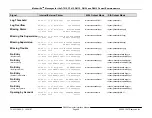
D6500 Computer Interface Manual
74-05313-000-G 10/16/97
Page 57
© 1988-1997 Radionics, Inc.
Numbered Table Notes:
1.
The program in the D7112/D9112 determines the formats of the user identification and point data
as they are sent to the automation system. If the panel requests a translation, the D6500 converts
point data to ZONEX format and user IDs to COMEX format. If there is no request for translation,
points and IDs are transmitted to automation and printed on the internal printer with no conversion.
User ID and point data are translated as shown below.
point
ZONEX
id
COMEX
001-008
100-800
0
0
009-024
101-116
1-5
001-005
025-040
201-216
0-13
601-608
041-056
301-316
14-21
701-708
057-072
401-416
22-29
801-808
073-088
501-516
30-37
B01-B08
089-104
601-616
38-45
C01-C08
105-120
701-716
46-53
D01-D08
121-136
801-816
54-61
E01-E08
137-152
117-132
62-69
F01-F08
153-168
217-232
70-249
000
169-184
317-332
185-200
417-432
201-216
517-532
217-232
617-632
233-247
717-731
2.
These messages are also capable of being transmitted by a D7112 via Modem II.
3.
The D6500 MPU program items BFSK Fire Bit, ModemIIe Fire and SIA Fire Restore determine
how the D6500 sends fire alarms, troubles, and restorals to the automation system. Refer to the
D6500 Security Receiver Program Entry Guide for specific details.
4.
Not used.
5.
When the D7112 is transmitting a test report in Modem II, the area # will be output to the
automation system if Output Format is set to SIA communications mode.
Example: <header>[#aaaa|OriaJL] for Log Threshold Since Last Call.
6.
When transmitted by a D7112, the identification number, if any, is also printed (see Forced Point,
D9112 Modem II "Other Reports" section).
7.
These messages can be turned off via the a "null phone#" for the event class. All messages in this
class exist in a unique event class.
8.
For these events, the area denotes the location of the keypad used to initiate the event (see Sensor
Reset).













































